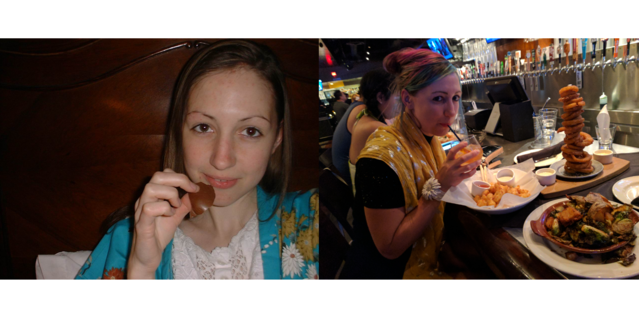Fear
10 Steps to Making and Following Your Recovery Plan
Recovery from anorexia is simple (if not easy): Part III (Making the plan)
Posted October 4, 2017
OK, so you’ve read the previous posts in this series (Part I and Part II), and you've at least ambivalently accepted the truth of the following propositions:
a) life will change only for the worse if I don’t eat more (see Part II)
b) eating more according to plan makes more sense than trying to do so without a plan (see Part I)
c) 500 kcal extra a day seems likely to yield the kind of change I want (at least part of me wants, part of the time)
Now what?
At this point, I should say: if you have access to professional support, seek it out. However sceptical you are about its usefulness, having help from someone who has seen it all before is probably better than not having it. It helped me a lot, and I started with an awful lot of scepticism. Their advice may differ from mine, and at that point you will have to decide which is most likely to get you to where you want to be. I return to this at the end. Meanwhile, for what it’s worth, my advice…
1. No, OK, of course your number doesn’t have to be 500. I imagine you’re already looking for reasons why it should be less: your whole family is delicately built, you’ve always gained weight really easily, your metabolism is permanently messed up... All these reasons, or excuses, reduce to fear and a refusal to admit how unremarkable your own condition is. Choose 400 if you must; you’ll only get to somewhere better slower. Choose 600 if you want; you’ll get there faster. 500, and 0.5 kg a week, is probably a reasonable balance between maintaining a decent rate of real change and preserving physical and psychological acceptability. This is presumably why it's also become a standard figure recommended as part of CBT treatment for eating disorders (see e.g. Murphy et al., 2010).
2. It doesn’t matter what you eat, as long as you can keep eating it. Sure, a nice macronutrient balance with the right sprinklings of essential vitamins and minerals would be great, but not if you never actually eat them, or stop eating them after a few days because you don’t like the taste, or they’re so expensive, or they take so long to prepare. The key is to keep eating. If you have to eat ten apples to make up your extra energy quota, do it that way. Hopefully they’ll get you to the point of being stronger enough, mentally and physically, and sick enough of apples, that by the time you can’t face a single Granny Smith more, you’re able to switch to something else. Conversely, if, like me, the only thing you’re willing to sacrifice starvation for is the ecstasy of refined sugars mixed generously with animal fats (in the form of sweet buttery pain au chocolat and sweet milky custard tart), do that.
The precise combination of energy types dwindles into insignificance next to the towering importance of simply giving the organism that is you the raw materials for repair and regeneration. The requisite chemical reactions will release energy stored in the ingested molecules to fuel the anabolic processes by which tissue is created – whether with glucose (from carbohydrate), fatty acids and glycerol (from fat), or amino acids (from protein) as the starting point. If you have serious specific deficiencies, again, it might be ideal to start to address them with carefully tailored nutritional decisions, but if you can’t do that now, it will be possible later. And actually, worrying about all that is probably mostly a distraction from the meat of the matter: just eating. Whatever you eat, you’re already doing enough, now, by tackling the central problem of generalised malnutrition.
So, work out something (or some combination of things) that fill you with least horror (or most excitement?) at the idea of eating them. If you like, go to a supermarket with a friend or a relative, and ask them to help you choose, as I did, and maybe even buy the first batch of them for you, as I did. Or simply add more of something you already eat – though the novelty of something distinct from your existing routines may be a helpful way of reinforcing the fact that something new really is happening now. Whatever works. Whatever makes least clear to you, straightaway, that this isn’t going to work.
3. Now, plan when in your day you’re going to eat the things you’ve chosen. Again, sustainability is paramount. The ideal would be to fill in some of the longest gaps between meals, to avoid long periods of fasting alternating with relatively large quantities of food eaten all at once, and so to help metabolism and appetite normalise. I decided to have the pain au chocolat as soon as I got up, and the custard tart once I was back from my bike ride and supermarket and library visits and the day’s other errands – i.e., I decided to fill in some of the terribly long gap there was in my day between getting up and eating all my food at once, right before sleep. And I found that once I’d decided on it, the prospect of having food first thing in the morning (well, because of my nocturnal habits, mid-afternoon) was actually the grandest imaginable relief, a merciful respite from the long bleak hungry routine – even if after a while it began to slide later again and had to be actively put back where it belonged. But if you can’t face eating at new/earlier times right now, don’t worry, you will later. So do what you can manage, even if that means simply tacking on the extra to your existing mealtimes. What matters most is that you don’t leave it undefined. Anorexia will take any route it can to avoid eating, and not having a time set in advance is a surefire way of letting it get what it wants – nearly as good a way as not deciding in advance what it is you’ll eat.
4. Decide to start tomorrow. There will always be reasons why tomorrow is not the perfect day. Ignore them. A night’s sleep is a powerful boundary between present and past, present and future: tomorrow, and this morning, can always be something new. Make today’s tomorrow be this for you, not tomorrow’s tomorrow or tomorrow’s tomorrow’s tomorrow.
5. Do all you need to prepare. Prepare practically. Buy the food. Set the alarm earlier, or make sure your work schedule has the time and the place for eating. Prepare for the fear, panic, disgust, rebellion, feverishness, pseudo-rationalisations against it. Do whatever you think might help to combat them. Maybe write a list of the reasons why you’re doing this, to have by you as you eat. Maybe plan to be with someone else during or before or after. Maybe have some music or a film or a book ready to immerse yourself in during or before or after. Above all, remind yourself as often as you need to that the decision is now made, and is, as far as tomorrow goes, irrevocable. You are going to do this. It’s no longer optional. You don’t expect it to feel good. You expect it to feel horrific. (Maybe it will surprise you by feeling at least partially wonderful, but you needn’t expect that.) If and when it feels horrific, that’s nothing but an unremarkable confirmation of your prediction – certainly no reason to change your plan. Anorexia is as transparent as a dog barking at a cat. Don’t let its tediously fractious tempers define your actions any longer.
6. When the day dawns, do as you planned. Observe how it feels. Maybe write something about it afterwards, if that’s a helpful way of processing it, of making it feel more real, more repeatable. Keep everything else as it always is: do not eat any less or exercise any more the rest of the day. Other dysfunctional habits you may have, closely or loosely bound up with the not-eating – don’t worry about them for now either. They’ll be far easier to address when you’re stronger.
7. Do this the next day, and the next day. Ideally weigh yourself once a week – no less, definitely no more – and record your bodyweight each time. See my post ‘To weigh or not to weigh’ for thoughts on why and how to do this.
8. When you get to BMI boundaries like 18, 19, or 20, or when you get to target weights you might have given by doctors in the past, if you still feel ill (preoccupied by food and your weight, depressed or unstable in mood, physically weak, etc.) and still feel hungry a lot of the time, don’t change anything. When your weight gain stops, if you still feel ill and still feel hungry a lot of the time, add more food, say 250 kcal more. If your hunger is so powerful that you feel in danger of starting to eat compulsively beyond your plan, increase the plan. If you simply feel ready to increase the plan – increase the plan. Repeat as necessary. The numbers are not your guide to where to stop. As my own BMI approached and surpassed 25, I made the mistake of listening to my therapist’s advice to cut out puddings and switch whole milk for semi-skimmed, then reversed that decision when I realised where it was leading. Anxiety alone is not a good reason to start restricting again, even if your therapist or doctor succumbs to some version of it too.
9. As time passes, practise treating your plan as a minimum. After a while, when you feel able (as you will) to eat extra little things that you wouldn’t normally, do it. Whenever you find yourself contemplating switching a standard meal for a much more calorific one, do it. Progress is a combination of letting nature take its course and giving it the odd prod in the right direction. Identifying the fact that progress has happened, by identifying and then acting on the feeling that you might be ready to give such a prod, is central to maintaining the progress. For me, a profound change came at the moment when – because of all the ways my emotional life had been re-emerging thanks to the extra food – my new boyfriend moved in with me and my daily baseline changed from the solitary meals I’d always eaten to the rich Germanic cooking he did for us both. At that point, recovery (and weight restoration) shifted up a gear, and the 500 ‘extra’ became irrelevant, because I was no longer eating to any kind of plan, and eating a hell of a lot, and mostly loving it. There may or may not be such a qualitative shift for you, but shifts will become possible as your body heals. you need to learn to look out for the moments when the momentum is there to help you step into the next phase.
10. Eventually, you will realise that you are not categorically ill any more: that your eternal hunger has subsided, that food has become one part of the day amongst many, that other interests and new ways of thinking are emerging. You will realise, probably with an odd sense that it's been true for a while already, that you really are becoming well again. At this point either your food intake will start reducing naturally, or (depending on what exactly your nutritional route to this point was) it won’t need to, because your metabolic rate will have adjusted upwards to mean you maintain on the same amount as what you were gaining on. I kept eating what I imagine was well over 3,000 calories a day for several years. I had thrown powerlifting into the mix too, and I can’t tell what might have been different otherwise; maybe my meat cravings wouldn’t have gone on quite so long – who knows. But after years of eating six chipolatas and three eggs for breakfast every morning, at some point I just stopped wanting to. (Then I dialled it back to my modest perennial favourite: fried egg, fried mushroom, and fried halloumi...) It's very hard to imagine, while still starving, that eating less could ever be a gentle, natural, easy thing to do. But once you really truly need less food, it will be.

I’m not trivialising these latter stages. There is much more to be said about them: about what it means to realise you are no longer ill, about how to deal with the bodily changes that eating brings, about the emotional work that needs to be tackled as the tidal wave of illness recedes, about all the ways in which life restructures itself around the new absence of starvation. I’ve written about some of these things in other posts: for example, in my posts on not stopping halfway, on identifying specific areas for pushing recovery further, on not being the thinnest any more, on (re)constructing a character, on seizing control and relinquishing it – and many others. Explore these as and when it’s helpful for you to. But for now, I hope it helps to have in mind a sense of the whole arc the basic recovery process can be expected to take, and how simple are the actions you need to take to get it all started and keep it going.
I’ve said all this in passing in many other places, but here it is. It is no guarantee of anything, except that if you follow it you will leave anorexia behind you. It is based as much on anecdotal evidence (my own and others’) as on scientific research. It raises questions about conflicts of priorities with professional medical guidelines, as tackled in this post. I will never tell you to go against your medical professional’s advice – except when you know that their advice is not in your best interests. And learning how to make that call, if and when you ever have to, is just one more part of the precarious yet in many ways oddly predictable business of coming back to life.
Let me know how you get on.
References
Murphy, R., Straebler, S., Cooper, Z., and Fairburn, C.G. (2010). Cognitive behavioral therapy for eating disorders. Psychiatric Clinics, 33(3), 611-627. Open-access full text here.




